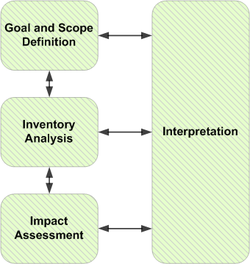
Life cycle assessment (LCA), also known as life cycle analysis, is a methodology for assessing environmental impacts associated with all the stages of the life cycle of a commercial product, process, or service. For instance, in the case of a manufactured product, environmental impacts are assessed from raw material extraction and processing (cradle), through the product's manufacture, distribution and use, to the recycling or final disposal of the materials composing it (grave).[1][2]
An LCA study involves a thorough inventory of the energy and materials that are required across the supply chain and value chain of a product, process or service, and calculates the corresponding emissions to the environment.[2] LCA thus assesses cumulative potential environmental impacts. The aim is to document and improve the overall environmental profile of the product[2] by serving as a holistic baseline upon which carbon footprints can be accurately compared.
The LCA method is based on ISO 14040 (2006) and ISO 14044 (2006) standards.[3][4] Widely recognized procedures for conducting LCAs are included in the 14000 series of environmental management standards of the International Organization for Standardization (ISO), in particular, in ISO 14040 and ISO 14044. ISO 14040 provides the 'principles and framework' of the Standard, while ISO 14044 provides an outline of the 'requirements and guidelines'. Generally, ISO 14040 was written for a managerial audience and ISO 14044 for practitioners.[5] As part of the introductory section of ISO 14040, LCA has been defined as the following:[6]
LCA studies the environmental aspects and potential impacts throughout a product's life cycle (i.e., cradle-to-grave) from raw materials acquisition through production, use and disposal. The general categories of environmental impacts needing consideration include resource use, human health, and ecological consequences.
Criticisms have been leveled against the LCA approach, both in general and with regard to specific cases (e.g., in the consistency of the methodology, the difficulty in performing, the cost in performing, revealing of intellectual property, and the understanding of system boundaries). When the understood methodology of performing an LCA is not followed, it can be completed based on a practitioner's views or the economic and political incentives of the sponsoring entity (an issue plaguing all known data-gathering practices). In turn, an LCA completed by 10 different parties could yield 10 different results. The ISO LCA Standard aims to normalize this; however, the guidelines are not overly restrictive and 10 different answers may still be generated.[5]
- ^ Cite error: The named reference
IlginGuptaJEM2010was invoked but never defined (see the help page). - ^ a b c "Life Cycle Assessment (LCA)". EPA.gov. Washington, DC. EPA National Risk Management Research Laboratory (NRMRL). 6 March 2012. Archived from the original on 6 March 2012. Retrieved 8 December 2019.
LCA is a technique to assess the environmental aspects and potential impacts associated with a product, process, or service, by: / * Compiling an inventory of relevant energy and material inputs and environmental releases/ * Evaluating the potential environmental impacts associated with identified inputs and releases / * Interpreting the results to help you make a more informed decision
- ^ "ISO 14040:2006". ISO.
- ^ "ISO 14044:2006". ISO.
- ^ a b Matthews, H. Scott, Chris T. Hendrickson, and Deanna H. Matthews (2014). Life Cycle Assessment: Quantitative Approaches for Decisions That Matter. pp. 83–95.
{{cite book}}: CS1 maint: multiple names: authors list (link) - ^ Klopffer, Walter and Birgit Grahl (2014). Life Cycle Assessment (LCA). Wiley-VCH Verlag GmbH & Co. KGaA. pp. 1–2.